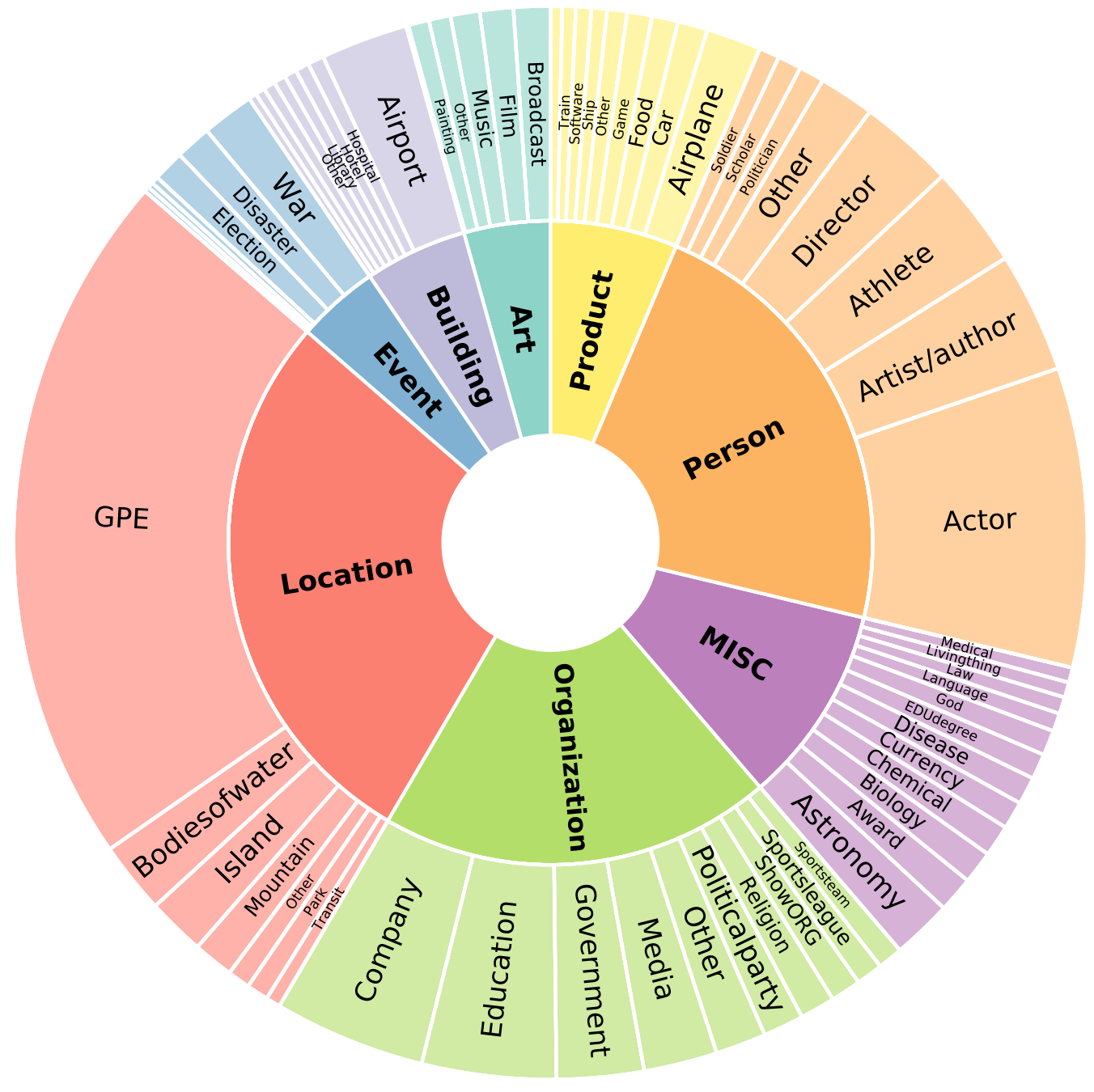This repo contains experimental source code for project titled "Exploring Deep learning approaches for few-shot Named Entity Recognition" being pursued as part of Deep learning course at IIT Hyderabad.
We have borrowed Few-NERD dataset and baseline systems for further experimentation. All credits go to Few-NERD: A Few-shot Named Entity Recognition Dataset. Check out the website of Few-NERD.
Few-NERD is a large-scale, fine-grained manually annotated named entity recognition dataset, which contains 8 coarse-grained types, 66 fine-grained types, 188,200 sentences, 491,711 entities and 4,601,223 tokens. Three benchmark tasks are built, one is supervised: Few-NERD (SUP) and the other two are few-shot: Few-NERD (INTRA) and Few-NERD (INTER).
The schema of Few-NERD is:
Few-NERD is manually annotated based on the context, for example, in the sentence "London is the fifth album by the British rock band…", the named entity London is labeled as Art-Music.
Run the following script to install the remaining dependencies,
pip install -r requirements.txt- Few-NERD contains 8 coarse-grained types, 66 fine-grained types, 188,200 sentences, 491,711 entities and 4,601,223 tokens.
- We have splitted the data into 3 training mode. One for supervised setting-
supervised, the other two for few-shot settinginterandintra. Each contains three filestrain.txt,dev.txt,test.txt.superviseddatasets are randomly split.interdatasets are randomly split within coarse type, i.e. each file contains all 8 coarse types but different fine-grained types.intradatasets are randomly split by coarse type. - The splitted dataset can be downloaded automatically once you run the model. If you want to download the data manually, run data/download.sh, remember to add parameter supervised/inter/intra to indicate the type of the dataset
To obtain the three benchmark datasets of Few-NERD, simply run the bash file data/download.sh with parameter supervised/inter/intra as below
bash data/download.sh supervisedTo get the data sampled by episode, run
bash data/download.sh episode-data
unzip -d data/ data/episode-data.zipThe data are pre-processed into the typical NER data forms as below (token\tlabel).
Between O
1789 O
and O
1793 O
he O
sat O
on O
a O
committee O
reviewing O
the O
administrative MISC-law
constitution MISC-law
of MISC-law
Galicia MISC-law
to O
little O
effect O
. OThe structure of our project is:
--util
| -- framework.py
| -- data_loader.py
| -- viterbi.py # viterbi decoder for structshot only
| -- word_encoder
| -- fewshotsampler.py
-- proto.py # prototypical model
-- nnshot.py # nnshot model
-- train_demo.py # main training scriptAs established in our paper, we design an N way K~2K shot sampling strategy in our work , the implementation is sat util/fewshotsampler.py.
Prototypical nets with BERT is implemented in model/proto.py.
NNShot with BERT is implemented in model/nnshot.py.
StructShot is realized by adding an extra viterbi decoder in util/framework.py.
Note that the backbone BERT encoder we used for structshot model is not pre-trained with NER task
Run train_demo.py. The arguments are presented below. The default parameters are for proto model on intermode dataset.
-- mode training mode, must be inter, intra, or supervised
-- trainN N in train
-- N N in val and test
-- K K shot
-- Q Num of query per class
-- batch_size batch size
-- train_iter num of iters in training
-- val_iter num of iters in validation
-- test_iter num of iters in testing
-- val_step val after training how many iters
-- model model name, must be proto, nnshot or structshot
-- max_length max length of tokenized sentence
-- lr learning rate
-- weight_decay weight decay
-- grad_iter accumulate gradient every x iterations
-- load_ckpt path to load model
-- save_ckpt path to save model
-- fp16 use nvidia apex fp16
-- only_test no training process, only test
-- ckpt_name checkpoint name
-- seed random seed
-- pretrain_ckpt bert pre-trained checkpoint
-- dot use dot instead of L2 distance in distance calculation
-- use_sgd_for_bert use SGD instead of AdamW for BERT.
# only for structshot
-- tau StructShot parameter to re-normalizes the transition probabilities-
For hyperparameter
--tauin structshot, we use0.32in 1-shot setting,0.318for 5-way-5-shot setting, and0.434for 10-way-5-shot setting. -
Take
structshotmodel oninterdataset for example, the expriments can be run as follows.
5-way-1~5-shot
python3 train_demo.py --mode inter \
--lr 1e-4 --batch_size 8 --trainN 5 --N 5 --K 1 --Q 1 \
--train_iter 10000 --val_iter 500 --test_iter 5000 --val_step 1000 \
--max_length 64 --model structshot --tau 0.325-way-5~10-shot
python3 train_demo.py --mode inter \
--lr 1e-4 --batch_size 1 --trainN 5 --N 5 --K 5 --Q 5 \
--train_iter 10000 --val_iter 500 --test_iter 5000 --val_step 1000 \
--max_length 32 --model structshot --tau 0.31810-way-1~5-shot
python3 train_demo.py --mode inter \
--lr 1e-4 --batch_size 4 --trainN 10 --N 10 --K 1 --Q 1 \
--train_iter 10000 --val_iter 500 --test_iter 5000 --val_step 1000 \
--max_length 64 --model structshot --tau 0.3210-way-5~10-shot
python3 train_demo.py --mode inter \
--lr 1e-4 --batch_size 1 --trainN 10 --N 10 --K 5 --Q 1 \
--train_iter 10000 --val_iter 500 --test_iter 5000 --val_step 1000 \
--max_length 32 --model structshot --tau 0.434@inproceedings{ding2021few,
title={Few-NERD: A Few-Shot Named Entity Recognition Dataset},
author={Ding, Ning and Xu, Guangwei and Chen, Yulin, and Wang, Xiaobin and Han, Xu and Xie, Pengjun and Zheng, Hai-Tao and Liu, Zhiyuan},
booktitle={ACL-IJCNLP},
year={2021}
}Few-NERD dataset is distributed under the CC BY-SA 4.0 license. The code is distributed under the Apache 2.0 license.

